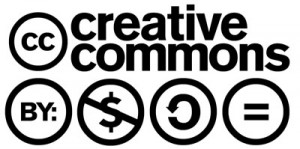Reading 02.1
Observation #1: Thank goodness the first ‘reading’ is a video.
Observation #2: Copyright is automatic upon creation.
Observation #3: Kiri’s Kiwi is not particularly friendly looking. (See 1:38 of this video explaining Creative Commons).
Observation #4: Creative Commons licenses are a way for an author to say ‘hey, you can use my work, as long as you attribute me’. This enables the flow and distribution of information, without having to continually grant permission for usage of the copyrighted content.
Observation #5: However, there are rules.

I sure hope this image has a Creative Commons license! To cover my bases, click the image to be taken to the original source.
- The first logo means attribution to the copyright holder must be present. This is automatic with Creative Commons licenses.
- The second logo means the content must be used for non-commercial purposes.
- The third logo means share alike, and requires that any work that includes the content must carry the same license.
- The fourth logo means no derivatives, i.e. you cannot change the content.
Observation #5.1: Jamendo sounds like an excellent resource for CC licensed music. Make mental note to check this website out.
Reading 02.2
Observation #6: Main legal issues that may arise for (Australian) bloggers are: copyright (surprise, surprise), moral rights, trade marks, defamation, and right of publicity.
Observation #7: Duration of copyright is generally the lifetime of the creator plus 70 years.
Observation #8: “You do not necessarily need a written agreement with every contributor to your blog – verbal permission is fine – but obtaining something in writing makes the terms of the licence (permission) clear to everyone.”
Observation #9: Ideas, facts, styles or techniques cannot be copyrighted. It is only the material form of the idea, fact, style or technique which is protected by copyright law.
Observation #10: If linking out to other websites on my blog, try to be sure that they are not infringing copyright.
Observation #11: There is no exception for “fair use” in Australia. Read more about the (somewhat) equivalent ‘fair dealing’ here.
Observation #12: Trade marks exist in two forms – registered trade marks and common law trade marks.
Observation #13: DO NOT DEFAME.
Observation #14: You may be responsible for material posted by other people on your blog (such as in the comments) and potentially liable for defamation. This applies to copyright infringement too.
Observation #15: There is a US-based international non-profit ‘digital rights’ group called the Electronic Frontier Foundation defending users’ civil liberties worldwide.
Observation #16: Freedom of speech is not written into the Australian Constitution, and as such, there is no explicit legal protection for acts of ‘freedom of speech’ like there is in the USA.
Observation #17: Remember that if you are operating your blog through a blogging service (like WordPress), you are liable to their Terms and Conditions. Yep, that sneaky little ‘agree’ button we all click after pretending to glance over the mountain of text that appears. I mean… sorry, what?
Reading 02.3
Observation #18: I love a bit of Lessig.
Observation #19: CC licenses are effective tools which facilitate and support the idea of remix culture and participatory culture.
Observation #20: Watch out for the creepy face-zoom at 3:25.
Observation #21: “That’s what literacy is, it’s the capacity to think critically, developed through a practice of using and reusing the creative work of others” – Lessig.
Observation #22: “We ought to use copyright law to enable the different business models of creativity, learning and knowledge that there are out there – not just the one [business model]” – Lessig.
Observation #23: Woah, this video was uploaded to YouTube in July 2006! YouTube was such a baby then! I’m pretty sure that’s just a few months before Google bought YouTube (in October…?).
Observation #24: Okay I’m not getting very distracted by reading about the history of YouTube.
OBSERVATION #25: OH MY GOD I JUST FOUND OUT GERIATRIC1927 (PETER OAKLEY) DIED IN MARCH. Ohhh he was such a great, pioneer of vlogging.
Observation #26: Alright, back to Lessig.
Observation #27: There’s no real way to measure how many CC licenses there are, but in the recording in 2006 Lessig said that we’re definitely in the tens of millions.
Reading 02.4
Observation #28: Here’s a link to the Creative Commons Australia website.
Reading 02.5
Observation #29: Why is this video talking about The White Stripes? Are they going to make an analogy about how we are The Seven Nation Army of Creative Commons License Holders??? (TSNAOCCLH – catchy, right?)
Observation #30: Oh it’s alright, they’re just here as a poetic example of the power of collaboration and co-authorship (see story about Redd Blood Cells). Great.
Observation #31: This video is really great. I dig the funky bass lines. But also, it really contextualises Creative Commons licenses by giving the history of how they came about.
Observation #32: CC isn’t supposed to compete with Copyright, but to complement it.
Reading 02.6
Observation #33: The Australian Copyright Council “supports a creative Australia by promoting the benefit of copyright for the common good” because “a society’s culture flourishes when its creators are secure in their right to benefit from their creative work and when access to those creative works is easy, legal and affordable.”
Observation #34: It’s bed time.